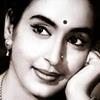Ahh first off, thanks for posting this theme, Madhu.
Raags are endlessly fascinating for me since it's a musical pattern/ format/ framework that is unique to only Indian Classical music. So it's safe to say there won't be any Western songs on this thread. Then again a site mentions Rasputin by Boney M as being derived from Aberi/ Bhimpalasi 
 .(Yeah, I don't know about that but I'm no expert.
.(Yeah, I don't know about that but I'm no expert.  )
)
And secondly, because they are such perfect examples of the juxtaposing of Music & Math.
Having been a student of music, and learning (& still trying to learn) the nuances of what makes each raag unique, this topic might be one in which I post than in any other! So please forgive my (over) enthusiasm!
Raags (or raagams as they're called down South) are formed by permutations and combinations of the Saptaswaras. These again are different in the two main forms of Indian Classical Music: Hindustani & Carnatic. Though there are some equivalencies such as Malkauns=Hindolam, Yaman=Kalyani, Bhoopali=Mohanam, Aberi=Bhimpalasi, Bilawal= Shankarabharanam, etc sometimes there are some subtle differences (that normally only connoisseurs can detect!) that makes it difficult to find an exact equivalent, so it's rounded up as a near equivalent.
How are raags formed? Well, they are a structure/ framework composed of combinations of the swaras. The note 'Sa' (Shadja) and 'Pa' (Panchama) are fixed and remain constant. However the other 5 swaras - Ri Ga Ma Dha Ni - have different forms based on the pitches (frequencies) at which they are rendered. Again, I believe there are differences in this variability in Hindustani and Carnatic music. Hindustani music has two forms of each of these notes (Komal and Shuddha and in some cases Teevra) whereas Carnatic music has 3 forms (except for Ma that has 2 forms).
Some ragas contain all 7 notes: Sa Ri Ga Ma Pa Dha Ni (formed by different permutations of the variations of Ri Ga Ma Dha & Ni) and these are called thaat or Melakarta raags.
All the other raags (that contain fewer than 7 notes) are derived from these Melakarta (Thaat) raags and are called Janya raags. There are 72 Melakarta raagams in Carnatic music (Math, people!  ) and several thousand (?) Janya raags that are derivatives. Hindustani music has 10 main thaats.
) and several thousand (?) Janya raags that are derivatives. Hindustani music has 10 main thaats.
Janya Raagams are a vast topic. And things are not as simple as saying so and so raag is a Janya of so and so Melakarta. Nope.
Since each raag has an ascending scale (aaroh or aarohanam) and a descending scale (Avroh or Avarohanam), one of them can be derived from one thaat and the other scale from a different thaat!
Then you can have asymmetric janya ragas.. with a different number of notes in the arohanam and avarohanam! Fascinating, no?
And the end result is a combination of notes that create a melody that evokes a particular mood and that determines the time of day it is suitable for! Like wow!
I've probably done a very rudimentary job of explaining but yeah, there you have it. The absolutely amazing musical framework that Indian songs are based on: A raag!
While raags maybe easier to identify when listening to Classical music since they are in their 'purest' forms, they continue to be an endless source of inspiration for film music - though much harder to identify and fix imo since they are rarely used in their purest forms. There is usually some 'mixing' in of non-raag elements or notational deviations or mixing of 2-3 different raags (what we call Raagamalika in which different portions of a song are based on different raags.)
There are some favorite filmi raags though & you'll find dozens of songs based on them - Yaman, Bhairavi, Sivaranjani, Pilu.. There's a standing joke in my family that when you cannot identify a raag in a film song and you know it's based off of one for sure, then it's probably Pilu!  (Or Bilawal in my case!
(Or Bilawal in my case!  )
)
Anyways, enough lecturebaazi but I just wanted to say a bit of raags and their derivation.
Moving on to filmi songs based on raags - most of them that have Indian roots are. But like I said earlier, it can be hard to pinpoint because film music composers are not restrained by the rigid framework of the raags and take many liberties which ends up 'diluting' a raag and therefore becomes much more difficult to identify.
I usually have a few 'textbook' songs as perfect examples of a particular raag and will usually 'refer' to them in my head while listening to a piece to determine if a song 'matches' it. That remains my method for identifying raags but it's definitely not foolproof. For eg. I would have never identified the song Tannu posted: "Kannalane (Kehna hi kya) as Bageshri when you compare it with the other Bageshri example that Madhu posted (Aaja re pardesi) or my textbook Bageshri examples (Radha na bole / Jaag dard-e-ishq).
So yeah, what do I know? 
I thought I'd post some of my favorite raagams and then post songs based off of them. I'll try and post a faithful (textbook) example and others that are not as faithful but are still great songs (or my favorites).
Madhu, you posted the absolutely stunning Jyoti Kalash Chalke from Bhabhi ki Choodiyan which remains my favorite example of Raag Bhoopali. I rarely feel this way but Sudhir Phadke's rendition of this song is possibly even more beautiful than Lata's. 
Bhoopali is derived from Kalyan thaat and is said to be closely related to another raag, Deshkar (Sayonara from Love in Tokyo is mentioned as an example of this raag - yeah idk how to distinguish) which is derived from Bilawal thaat (yeah don't ask me how the Math works here!)
Here's another song in Raag Bhoopali that I absolutely love (it simply oozes divinity  )and uphold as a textbook example of this raag.
)and uphold as a textbook example of this raag.
Ghanashyam Sundara Shreedhara (Marathi)
Film: Amar Bhoopali (1951)
Music: Vasant Desai
Lyrics: Kavi Honaji Bala
Singers: Panditrao Nagarkar, Lata Mangeshkar
https://www.youtube.com/watch?v=YpBqoVVYyYw
Edited by LizzieBennet - 1 years ago










 .(Yeah, I don't know about that but I'm no expert.
.(Yeah, I don't know about that but I'm no expert.  )
) ) and several thousand (?) Janya raags that are derivatives. Hindustani music has 10 main thaats.
) and several thousand (?) Janya raags that are derivatives. Hindustani music has 10 main thaats.  (Or Bilawal in my case!
(Or Bilawal in my case!  )
)


comment:
p_commentcount